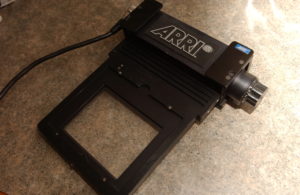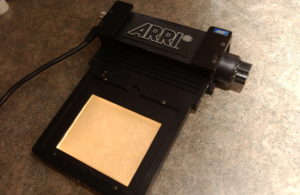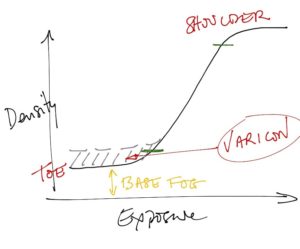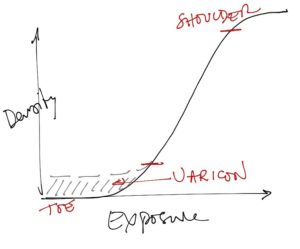I have been using the Varicon (on film primarily but also in HD) since it was first produced by Arriflex. It allows me to have maximum control over density AND detail(without the need to set up fill light) in the blacks without any noise penalty.

Arriflex Varicon - Source Off
For those who have not seen it..it is a lightsource that essentially illuminates a glass filter and basically fogs the entire image. The trick however is that the light only registers in the shadow areas…it does not affect the midrange or highlights (unless the level is cranked up way too high).
Varicon was developed from an older system called Lightflex which was used extensively by Freddie Francis BSC and was purchased by Arri back in the 80’s. Lightflex was huge and cumbersome. It was almost a construction when mounting it to the lens and was powered by an equally large transformer in a huge box. Shortly after purchasing Lightflex, Arri’s resident “mad scientist” Stan Roth went to work developing the system into something much smaller and more effective. The result was the Varicon, a unit taking up two filter slots in an MB14 mattebox with a variable intensity light source (no change in color temp) and even light spread across the entire frame. (Those parameters took some time to master).
What does the Varicon do?
Essentially it works exactly the same as pre-flashing the negative (in film). Pre flashing works in the “toe” of the curve, raising the base fog level and increasing sensitivity in the shadow area of the negative. It does exactly the same thing in video (although there is no base fog in video)…so it works in a similar way to raising the pedestal. The result is a slight fogging of the blacks and approx 1-2 stops more detail in the shadow areas.
Why not simply raise the Pedestal?
We all know that every adjustment on a video camera has a price tag attached. Raising the pedestal, however slightly, will increase noise in the shadows. The advantage of using the Varicon is I can increase shadow detail with no noise penalty as there is now light in the shadow areas which was not there before. Of course the ped is now raised (giving the image milky blacks) so it is a simple matter of pulling the ped back down in color grading and now we have rich blacks AND shadow detail. The benefit…I can place the level of shadow detail wherever I want it without any noise penalty whatever. If I shot without the varicon and tried to pull detail out in post…I may get detail but I also get more noise. Pulling the blacks down when they already contain detail gives me the rich blacks I want PLUS the shadow detail wherever I decide to set it.
Why use the Varicon?
I could never understand why more DP’s, especially those shooting for TV, did not use the Varicon. The advantages were obvious. On film, with limited “dynamic range” the varicon was a real time saver. I used it on anything I shot, on film, for TV as it allowed me to shoot at wide apertures, setting the key, making use of spill and then adding “fill” using the varicon. On a TV series this can mean 2-3 (sometimes more) additional setups, in the same number of hours, per day. Directors and Editors love that. However the other advantage is it allows for very careful manipulation of the shadows and shadow detail and again it is very fast. Another big plus is it works equally well on day exteriors as in low light interiors…digging into shadows under trees and pulling detail where you normally would not see it without the use of sources that could compete with the sun.
In JEREZ I used it for all footage we shot in a Cooperage. Light levels were extremely low meaning I had to shoot wide open and/or bump up the ISO. I needed to shoot wide open to make as much use of what little light was available since the location was quite a dangerous workplace and impossible to place lights in a safe way. However, I would not have used lights anyway…preferring to make use, as is my preferred lighting style, of as much natural light as possible. Shooting wide open is no problem but I did not want to be wider than a 2.8 so I could hold at least minimal depth of field using 100-200mm lenses. Even at 2.8 on a 200mm lens depth of field is not much more than 1 inch. There was the option to go to 1.3 Zeiss super speeds but depth of field was too shallow at those apertures given the focal lengths I wanted to be shooting.
I also prefer not to raise the ISO too far, again to minimize noise. So my goal was T2.8 and ISO400. This was a challenge and meant my highlights and mid-range were OK but shadow areas simply fell away to black or had very minimal detail. One more consideration is, for me, the varicon helps give HD a more “film like” appearance.
ENTER VARICON. This is where the Varicon really shines. Using the unit I knew I would have an additional 1-2 stops in the shadow areas (effectively ISO800-1600) and this would be exactly what I needed to dig out enough detail in shots that were exposed to hold the highlights or mid range. Once again the real benefit being…total control over both density of the blacks and detail in the blacks without having to deal with increased noise.


